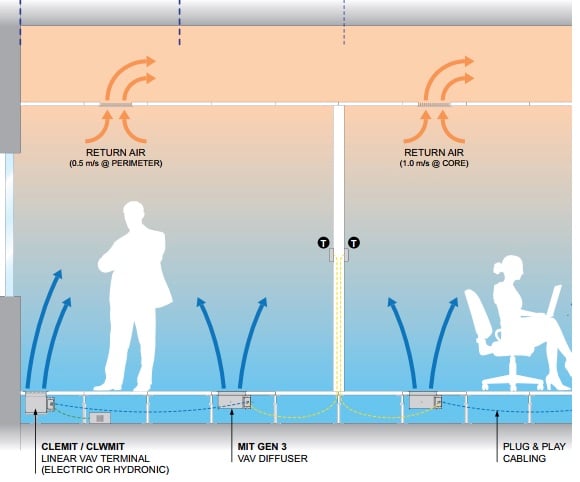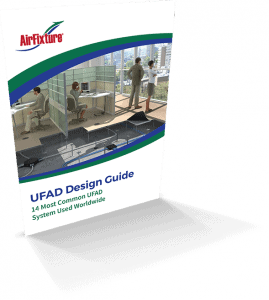5 Myths About UFAD Systems
Debunking 5 Myths About UFAD: Underfloor Air Distribution Underfloor air distribution can be a great option for any business or home. Its...
Floor, wall and ceiling mounted to meet your unique project design.

Architects and building designers face difficult decisions when developing a design for a new or retrofitted building. From ceiling heights to complex essential building systems, architects and developers are finding unique solutions to create a forward-thinking space. Among these unique solutions are underfloor air distribution (UFAD) systems.
UFAD systems present significant advantages over traditional HVAC systems and can be a great option for architects looking to create an efficient, comfortable environment, while continuing to focus on an elevated design. An often-misunderstood solution to heating and cooling, contractors and developers have accepted common myths about UFAD systems. It’s important for architects and other building developers to understand the basic mechanics, benefits and challenges that UFAD systems present.
Underfloor air distribution systems (UFADs) route heated and cooled air through a plenum system housed underneath a raised access floor. As the air rises through the breathing zone, the return air is sent back in at the ceiling to remove warm air faster than traditional overhead VAV systems. Because the air is pulled upward through the room by naturally offering thermodynamic properties, the tempered air is spread more evenly and consistently throughout the space.
The raised access floor system allows for easy access maintenance or even upgrades as needed. Additionally, space in the raised floor area can also be used to route other mechanical, electrical and plumbing essential building systems while saving overhead space.
From energy efficiency to architectural excellence, UFAD systems can provide many benefits to an architect’s building design plans.
Due to the use of thermodynamic properties, UFAD systems are highly energy efficient climate control units. That improved energy efficiency can often help architects secure LEED, ENERGY STAR and other sustainability credits and certifications, raising the sustainability and notability of the project.
Indoor air quality standards from governing bodies including the EPA and ASHRAE are consistently rising – and for good reason. With the majority of our days spent indoors, having clean, healthy air to breath is essential for workplace and personal safety. UFAD systems limit exposure to pollutants, including dust and pollen, with diffusers that capture particles with its low-velocity supply of fresh air into the primary breathing zone. These systems are easy to maintain with clear access points for regular cleaning.
The consistent supply of temperature-controlled air through a UFAD system with diffusers placed strategically provides a reliable temperature throughout the room. The diffusers reduce unwanted hot or cool spots and gravity’s effect on heated air in the breathing zone allows for a constant replacement with fresh, tempered air. Because of these, UFAD systems can greatly increase occupant comfort.
Traditional overhead VAV systems, while also an eyesore, are very loud. UFAD systems don’t rely on the same large fans and ductwork that make overhead systems so noisy. In fact, AirFixture’s UFAD systems are very quiet, rated at a Noise Criterion level 18 – the most often used metric to measure background noise in a space.
Because UFAD systems are carefully hidden under raised flooring, architects and engineers have the opportunity to let their building shine. Overhead VAV systems cover the ceiling of a building allowing no room for eye-catching art or unique architectural features. By hiding away essential building systems in the raised floor, architects can be more creative with their building design.
Challenges of Underfloor Air Distribution
Installing a UFAD system can be incredibly beneficial for energy efficiency, architectural aesthetics and more. Not everything is perfect, and there are a few challenges with UFAD systems.
UFAD systems are a premium solution to traditional HVAC building systems. With premium quality comes premium prices. UFAD systems are typically more expensive in their upfront costs when compared to traditional overhead systems. However, with long-term energy savings from their high efficiency, the up-front costs of installing UFAD balance out over time, becoming more cost effective for building owners in the long term. The initial investment in a UFAD system pays off in the long run.
Because overhead HVAC systems have been the most popular option for decades, many existing buildings are already equipped with inherited systems. To install UFAD, spaces need to be retrofitted with raised access flooring and demolition to remove the existing air ducts. This retrofitting can be costly during installation.
UFAD systems are quick and easy to install. Our trained MEP engineering professionals work directly with our clients to ensure easy access for future maintenance and upgrades. The raised flooring housing of the UFAD unit allows for safe and easy maintenance. Commercial UFAD providers often include maintenance guides or direct personal maintenance services to keep your system running smoothly.

Understanding UFAD and other essential building systems is paramount for architects and engineers to design efficient buildings of the future. At AirFixture, we understand that UFAD systems are not the most common technology, that’s why we created our Complete Guide to Underfloor Air Distribution and Complete Guide to Raised Floors. Our support and sales teams around the world are on call to help answer any questions on the process, design, installation and customization of our products and provide additional resources.
Is UFAD right for your design?
UFAD systems improve energy efficiency, indoor air quality and occupant comfort. These systems can be long-term game changes for architects, engineers, real estate developers and building owners looking to create exciting and engaging designs. Is UFAD right for your design? Contact us today to learn how the AirFixture team can support you.

Debunking 5 Myths About UFAD: Underfloor Air Distribution Underfloor air distribution can be a great option for any business or home. Its...

Air quality impacts productivity, especially in offices, and Underfloor Air Distribution Systems (UFAD systems) are a cost-efficient solution. With a...

Today’s economy continues to see a relative flatlining of the commercial building sector. Occupancy growth is continuing to slow, with one study...